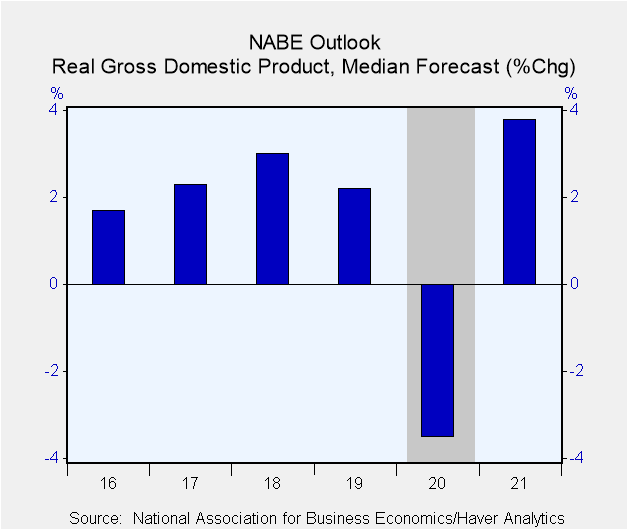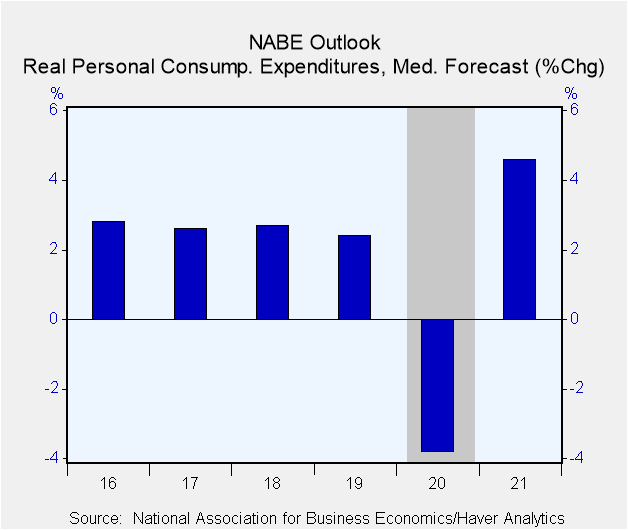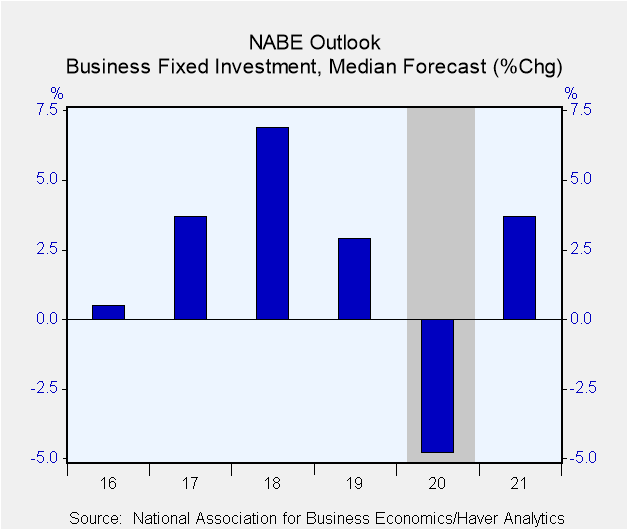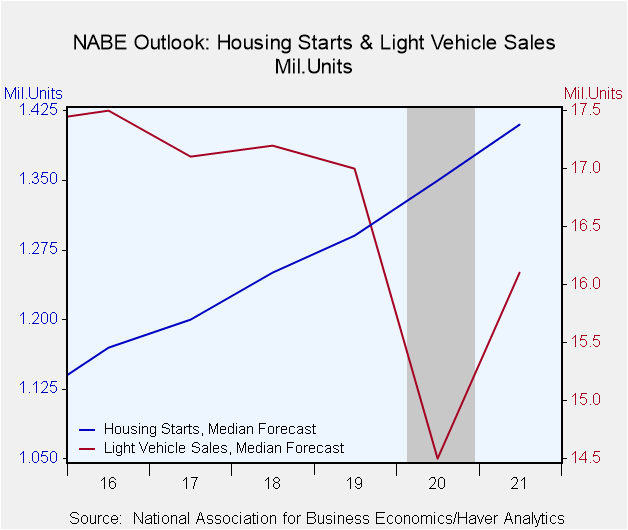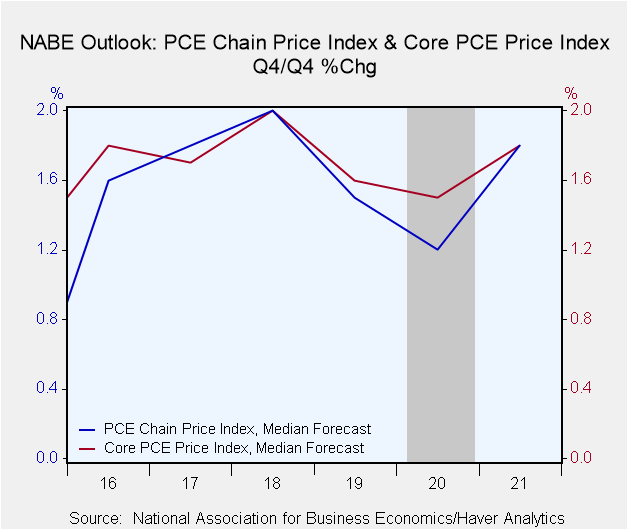 Global| Dec 07 2020
Global| Dec 07 2020NABE Increases 2021 Growth Expectations, Forecasting More Consumer Spending
by:Tom Moeller
|in:Economy in Brief
Summary
The National Association for Business Economics raised its projection for real GDP growth in 2021 to 3.8% from 3.6%. This follows a record recession this year, with GDP expected to contract 3.5%, versus the prior forecast of a 4.3% [...]
The National Association for Business Economics raised its projection for real GDP growth in 2021 to 3.8% from 3.6%. This follows a record recession this year, with GDP expected to contract 3.5%, versus the prior forecast of a 4.3% decline. Quarterly growth is expected to average 3.4% next year, revised from 3.6%, after quarterly declines averaging 3.8% this year, revised from -3.9%. Personal consumption expenditures are forecast to improve 4.6% in 2021, revised from 4.1%, after falling 3.8% in 2020, revised from -4.6%. Business fixed investment growth is expected to rise 3.7% next year, revised from 2.4% and recover most of this year's 4.8% fall, revised from -6.0%. Expected growth of 6.8% in residential investment next year, revised from 3.5%, will follow 4.4% growth in 2020, revised from the 1.1% previously expected. Government spending growth is expected to slow to 0.2%, earlier estimated to be 0.9%, and then move down sharply from gains this year and in 2019. Deterioration in net exports is forecast to continue next year at an increased rate. Slow recoveries abroad are expected to limit U.S. export growth to 5.2% next year versus an 8.0% rise in imports. In the current year, exports are now projected to decline an unrevised 13.5%, while imports are forecasted to drop by 10.4%, revised from -12.3%. The expected rate of inventory investment is expected to pick up next year after a sharp rate of decumulation in 2020.
Housing starts are forecasted to rise next year to an average 1.41 million units, revised from 1.35 million, and add to this year's rise to an unrevised 1.35 million. Expected light vehicle sales of 16.1 million units next year was lifted from 15.8 million units, after falling to 14.5 million this year, revised from 14.1 million. Sales should remain below the 2016 peak of 17.5 million. An average monthly gain in payroll employment of 387,000 next year (earlier projected as 350,000) recovers from a little-changed 681,000 decline this year. Expectations for the unemployment rate in 2021 place it at 6.3%, revised from 6.8%, following 8.1% this year, revised from 8.4%.
The Consumer Price Index is projected to rise 2.0% Q4/Q4 in 2021, revised from 1.9%, versus 1.2% this year, which was changed from 1.1%. Price inflation next year, as measured by the PCE price index, is expected to rise1.8%, revised from 1.9% Q4/Q4 from an estimated 1.2% this year, changed from 1.1%. The chain PCE price index excluding food & energy should rise 1.8% next year (Q4/Q4), revised from 1.6%, after increasing 1.5% this year, changed from 1.2%. The cost of crude oil is expected to average a little-changed $46 per barrel at the end of 2021, rising slightly versus a projected $41 at the end of 2020.
The forecasted 1.15% interest rate on a ten-year Treasury note at yearend 2021 was increased from 1.1% and compares to 0.84% at the end of 2020, revised from 0.75%. The Federal funds rate is projected to be steady around 0.125% until the end of next year. After-tax corporate profits should rise 9.5% next year, revised from 8.5%, after a 9.8% decline in 2020, revised from -11.0%. The expected Federal government budget deficit should surge to a slightly reduced expectation of $3.132 trillion in FY20, then ease to $2.185 trillion next year, revised from $1.981.
The figures from the latest NABE report can be found in Haver's SURVEYS database.
The Fed's latest Beige Book covering regional economic conditions is available here.
| National Association For Business Economics | 2021 | 2020 | 2019 | 2018 | 2017 |
|---|---|---|---|---|---|
| Real GDP (% Chg. SAAR) | 3.8 | -3.5 | 2.2 | 3.0 | 2.3 |
| Personal Consumption Expenditures | 4.6 | -3.8 | 2.4 | 2.7 | 2.6 |
| Business Fixed Investment | 3.7 | -4.8 | 2.9 | 6.9 | 3.7 |
| Residential Investment | 6.8 | 4.4 | -1.7 | -0.6 | 4.0 |
| Gov't Consumption & Gross Investment | 0.2 | 1.2 | 2.3 | 1.8 | 0.9 |
| Change in Real Business Inventories (Bil. $) | 54 | -83.0 | 48.5 | 53.4 | 15.8 |
| Net Exports (Bil. $) | -1,028 | -899.0 | -917.6 | -877.7 | -816.8 |
| Housing Starts (Mil. Units) | 1.41 | 1.35 | 1.29 | 1.25 | 1.20 |
| Light Vehicle Sales (Mil. Units) | 16.1 | 14.5 | 17.0 | 17.2 | 17.1 |
| Payroll Employment Average Monthly Change (000s) | 387 | -681 | 178 | 193 | 176 |
| Civilian Unemployment Rate (%) | 6.3 | 8.1 | 3.7 | 3.9 | 4.3 |
| Consumer Price Index (Q4/Q4 %) | 2.0 | 1.2 | 2.0 | 2.2 | 2.1 |
| Chain Price Index for PCE (Q4/Q4 %) | 1.8 | 1.2 | 1.5 | 2.0 | 1.8 |
| Chain Price Index excl. Food & Energy (Q4/Q4 %) | 1.8 | 1.5 | 1.6 | 2.0 | 1.7 |
| Fed Funds Rate (%, Year-End) | 0.125 | 0.125 | 1.625 | 2.375 | 1.375 |
| 10-Year Treasury Note (%, Year-End) | 1.15 | 0.84 | 1.92 | 2.69 | 2.40 |
Tom Moeller
AuthorMore in Author Profile »Prior to joining Haver Analytics in 2000, Mr. Moeller worked as the Economist at Chancellor Capital Management from 1985 to 1999. There, he developed comprehensive economic forecasts and interpreted economic data for equity and fixed income portfolio managers. Also at Chancellor, Mr. Moeller worked as an equity analyst and was responsible for researching and rating companies in the economically sensitive automobile and housing industries for investment in Chancellor’s equity portfolio. Prior to joining Chancellor, Mr. Moeller was an Economist at Citibank from 1979 to 1984. He also analyzed pricing behavior in the metals industry for the Council on Wage and Price Stability in Washington, D.C. In 1999, Mr. Moeller received the award for most accurate forecast from the Forecasters' Club of New York. From 1990 to 1992 he was President of the New York Association for Business Economists. Mr. Moeller earned an M.B.A. in Finance from Fordham University, where he graduated in 1987. He holds a Bachelor of Arts in Economics from George Washington University.


